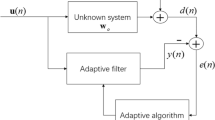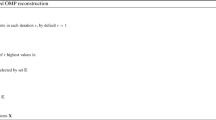Abstract
The Hilbert transform has been recognized as an important method in circuit theory. One of its important applications is related to the gain–phase relationship. Many practical methods have been derived from the Hilbert transform to calculate the analog phase samples from the analog gain samples. However, the use of the discrete Hilbert transform is not so common in phase approximation through gain samples. One reason may be related to the possible presence of aliasing. In this paper, we show that yet another inconvenience can occur when it is desired to obtain some samples of the phase using the discrete Hilbert transform of the gain samples: the minimum-phase sequences of finite length allow only zero total net phase change. Thus, the computation of the analog phase samples using the discrete Hilbert transform is convenient only when its net phase change of the analog circuit is also zero.




Similar content being viewed by others
Data availability
Our manuscript has data included as electronic supplementary material.
References
T. Andersson, J. Johansson, H. Eklund, Numerical solution of the Hilbert transform for phase calculation from an amplitude spectrum. Math. Comput. Simul. XXIII, 262–266 (1981)
H.W. Bode, Network Analysis and Feedback Amplifier Design (D. Van Nostrand, Princeton, 1945)
K. Diethelm, A method for the practical evaluation of the Hilbert transform on the real line. J. Comput. Appl. Math. 112, 45–53 (1999)
I.M. Gel’fand, G.E. Shilov, Generalized Functions (Academic Press, New York, 1968)
E.A. Guillemin, Synthesis of Passive Networks (Wiley, London, 1957)
M.H. Hayes, J.S. Lim, A.V. Oppenheim, Signal reconstruction from phase or magnitude. IEEE Trans. Acoust. Speech Signal Process. ASSP–28(6), 672–680 (1980)
D.W. Kammler, A First Course in Fourier Analysis (Prentice Hall, Upper Saddle River, 2000)
F.W. King, Efficient numerical approach to the evaluation of Kramers-Kronig tranforms. J. Opt. Soc. Am. B 19(10), 2427–2436 (2002)
F.W. King, Hilbert Transforms, Encyclopedia of Mathematics and its Applications, vol. 2 (Cambridge University Press, Cambridge, 2009)
S.K. Mitra, Digital Signal Processing: A Computer Based Approach (McGrawHill, NewYork, 1998)
G.C. Newton, L.A. Gould, J.F. Kaiser, Analytical Design of Linear Feedback Controls (Wiley, London, 1957)
A.V. Oppenheim, R.W. Schafer, Discrete-Time Signal Processing (Prentice-Hall, Englewood Cliffs, 1989)
A. Papoulis, The Fourier Integral and Its Applications (McGraw-Hill, New York, 1962)
J.G. Proakis, D.G. Manolakis, Introduction to Digital Signal Processing (Macmillan, New York, 1988)
C. Rusu, Selected issues in phase approximation, in Festchrift in Honor of Jaakko Astola on the Occasion of his 60th Birthday, pp. 49–59 (2009)
C. Rusu, I. Gavrea, P. Kuosmanen, Deriving phase from logarithmic gain derivatives. Circuits Syst. Signal Process. 21(3), 243–261 (2002)
C. Rusu, P. Kuosmanen, Phase approximation by logarithmic sampling of gain. IEEE Trans. Circuits Syst. II Analog Digital Signal Process. 50(2), 93–101 (2003)
P. Sabherwal, M. Agrawal, L. Singh, Automatic detection of the R peaks in single-lead ECG signal. Circuits Syst. Signal Process. 36, 4637–4652 (2017)
R. Venkatesan, A. Ganesh, Binaural classification-based speech segregation and robust speaker recognition system. Circuits Syst. Signal Process. 37, 3383–3411 (2018)
L.A. Zadeh, C.A. Desoer, Linear System Theory (Mc Graw Hill, New York, 1969)
Acknowledgements
This work was supported by a grant of the Romanian Ministry of Research and Innovation, CCCDI - UEFISCDI, Project Number 52/2020, PN-III-P2-2.1-PTE-2019-0867, within PNCDI III.
Author information
Authors and Affiliations
Corresponding author
Ethics declarations
Conflict of interest
The authors declare that they have no conflict of interest.
Additional information
Publisher's Note
Springer Nature remains neutral with regard to jurisdictional claims in published maps and institutional affiliations.
Appendices
Appendix A
Let us consider a causal finite-length minimum-phase sequence \( \{ x(n) \}\), \(n=0,1,\ldots ,N-1\). Its z-transform X(z) can be written as:
where \(z_k=|z_k|e^{j \angle z_k}\) are its zeros inside the unit circle (\(0 \le |z_k| <1, \forall k=0,1,\ldots ,N-1\)).
Now let us focus on a single term \(X_k(z) = 1-z_kz^{-1} \) and compute its net phase change: \(\angle X(e^ {j \pi }) - \angle X(e^{- j \pi })\).
First we note that \(X_k(e^{j \omega }) = 1-|z_k|e^{j \angle z_k}e^{ -j \omega }= 1 -|z_k| [ \cos ( \omega - \angle z_k) + j \sin (\omega - \angle z_k) ] \) and its real part \(1 -|z_k| \cos ( \omega - \angle z_k)\) is always positive. Consequently, its argument is done by
it is continuous and its derivative is also continuous. It follows that
By using (9), we obtain that the overall net phase change of X(z) is zero.
Appendix B
Let us consider a causal system having
where \(Z_k=\Re (Z_k) + j \Im (Z_k)\), with \(\Re (Z_k) < 0\), and \(P_k=\Re (P_k) + j \Im (P_k)\), with \(\Re (P_k) < 0\)
Let us analyze the net phase change of the term \(H_k(s)=s-Z_k\). We have:
and it is continuous and its derivative is continuous. We get
The terms that contain poles have the same behavior. Consequently, H(s) has an overall net phase change of zero if and only if \(M=N\).
Rights and permissions
About this article
Cite this article
Rusu, C., Grama, L. Analog Phase Samples Approximation from Gain Samples by Discrete Hilbert Transform. Circuits Syst Signal Process 41, 4136–4148 (2022). https://doi.org/10.1007/s00034-022-01965-0
Received:
Revised:
Accepted:
Published:
Issue Date:
DOI: https://doi.org/10.1007/s00034-022-01965-0




